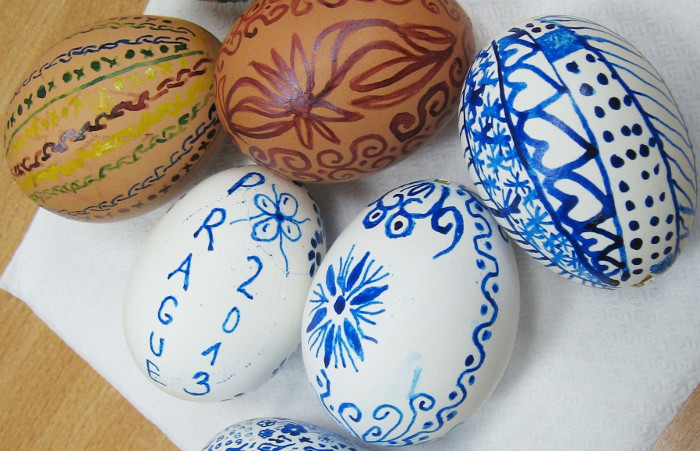Grass growing, flowers blooming, and new life suggest the awaking of nature and the official start of spring. Springtime is the season in which life is at the centre of existence, it allows the idea of rebirth, rejuvenation, and regrowth. Not only is spring a celebration of new life, it is also a time of celebrating festivals and historical traditions.
Being an Erasmus student from England (Natasha Gooden studies currently at Faculty of Law of Charles University and comes from University of Sheffield) I have experienced many of my home cultures and traditions surrounding springtime. I recently took part in the Europe Meets School Programme, where I volunteered in a local Czech school, and prepared and delivered a project called British Holidays and Traditions. After an informative presentation I had prepared a task which was to produce posters highlighting British holidays and Czech holidays which included the similarities and differences of the two counties. During my visit I hopefully informed the children, however they also shared their traditions and I also went away from the experience gaining further knowledge, which I have used to base my article upon.
Veselé Velikonoce; Happy Easter!
One of the main spring festivals is Easter, originating from religious roots; Easter in both countries encompasses the best of spring along with unique touches of creativity.
Throughout the Czech Republic there are many symbols of Easter, one of those is that of Kraslice, which are special eggs that are hand painted and decorated, creatively made using different materials such watercolours, stickers, and with a wide ranging patterns which are at the heart of Easter celebrations.
One tradition which is unique to Czech Republic and would not make it Easter without it is that of pomlázka. I had previously not come across this tradition as it is not done in England, it is where pussywillow twigs are braided together in order to make whips, which has been passed down through many generations, boys will whip girls in order to bring health and youth. Dousing is symbolically similar in tradition whereas in this instance a girl is doused in water.
Whereas in England there is a more reserve approach, a key tradition for children is to make Easter bonnets, which are often straw hats which are decorated with chicks, and flowers. A further English tradition is an Easter egg hunt, where adults would hide treats such as chocolate eggs in order for children to find them. A favourite food traditionally eaten is a hot cross bun, which spiced buns with crosses on the top and usually eaten on Good Friday. Additionally on Easter Sunday children receive a basket of chocolate treats and sweets from the Easter Bunny.
Both countries value the connotations of colour, however there is a key difference in colour choices, while in the Czech Republic red if often used, in England greens and yellows are used, although despite the differences they both symbolise happiness, joy and new life.
Underpinning Easter is the religious aspects of the resurrection of Jesus Christ. Czechs have numerous religious days such as: Ugly Wednesday (Škaredá středa), Green Thursday (Zelený čtvrtek), Good Friday (Velký pátek), White Saturday (Bílá sobota), which are traditionally based on the creation of wooden rattles – řehtačka, which boys would walk through villages and make noise, which symbolically would be to warn off Judas.
 They also celebrate other days which are better known for me personally, which include Easter Sunday (Neděle velikonoční), however unlike English traditions preparations for Easter Monday take place, girls paint eggs and boys prepare their pomlázka. In England this is the most Holy day where people would attend Sunday Mass, this would then usually follow with a traditional Sunday roast dinner comprising of roast lamb. In comparison in Czech Republic Easter Monday (Pondělí velikonoční) is the main day as this is when the whipping would take place, and the girls would offer decorated eggs as a reward.
They also celebrate other days which are better known for me personally, which include Easter Sunday (Neděle velikonoční), however unlike English traditions preparations for Easter Monday take place, girls paint eggs and boys prepare their pomlázka. In England this is the most Holy day where people would attend Sunday Mass, this would then usually follow with a traditional Sunday roast dinner comprising of roast lamb. In comparison in Czech Republic Easter Monday (Pondělí velikonoční) is the main day as this is when the whipping would take place, and the girls would offer decorated eggs as a reward.
Goodbye Winter; Hello Summer
Burning of the witches (Pálení čarodějnic) takes place on the 30th
May Day
The first of May is celebrated in both countries and depicts spring at its best. In Czech Republic young people in villages decorate májka which is a birch tree which is placed on a village green, and people from neighbouring villages may try and steal it. A similar approach is taken in England, as a wooden pole/branch the maypole is at the centre of the day. It would usually consist of dancing around the maypole with ribbons, and celebrating life. Similarly it is a time of love and romance in both countries, as in Czech Republic also known as the day of love.
Traditions – Strange but intriguing
Peculiar, unusual, weird are often words used to describe springtime traditions; however the creative and innovative forms of celebration from both countries highlight the fun and excitement of spring, and emphasize the importance of keeping traditions alive. Despite physical differences it is clear that the same beliefs and messages are being portrayed and highlighting that you are never far away from what you already know. The differences make each place unique and a great place to visit and experience.
Spring: A celebration of people and life.















